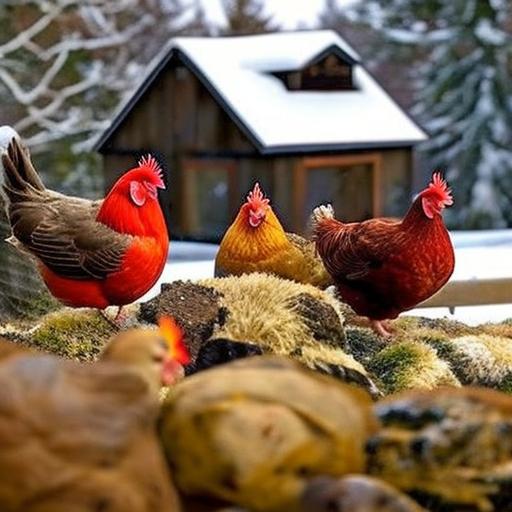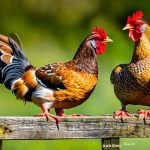Keeping chickens warm in winter is an important aspect of caring for these beloved backyard pets. As the temperatures drop and the days become shorter, it’s crucial to ensure that chickens are comfortable and healthy during the colder months. In this blog post, we will discuss various tips and strategies for keeping chickens warm in winter. So grab a cup of hot cocoa, cozy up by the fire, and let’s dive into the world of winter chicken care.
Key Takeaways
- Chickens have specific needs during winter that require attention and preparation.
- Choosing the right chicken coop and insulating it properly is crucial for keeping chickens warm.
- Adequate ventilation is important to prevent moisture buildup and maintain air quality.
- Heat lamps or heaters can be used, but caution must be taken to prevent fires and overheating.
- Feeding a high-quality diet and preventing frostbite are also important for winter chicken care.
Understanding the Winter Needs of Chickens
Chickens are affected by cold weather in several ways. Firstly, their bodies are not as well-equipped to handle extreme temperatures as other animals. Chickens lack a layer of insulating fat and have minimal feather coverage on their feet and combs, making them susceptible to frostbite. Additionally, chickens are more prone to respiratory issues during winter due to poor ventilation in their coops.
Keeping chickens warm and healthy during winter is crucial for their overall well-being. Cold temperatures can cause stress, which can lead to a decrease in egg production and even illness. It’s important to provide a comfortable environment for chickens to thrive in during the colder months.
Some common winter health concerns for chickens include frostbite, respiratory infections, and decreased egg production. Frostbite occurs when the comb, wattles, or feet are exposed to freezing temperatures for extended periods. Respiratory infections can occur when chickens are exposed to drafts or poor ventilation in their coops. Lastly, decreased egg production is a common issue during winter due to the shorter days and colder temperatures.
Choosing the Right Chicken Coop for Winter
The chicken coop plays a vital role in keeping chickens warm during winter. It provides shelter from the elements and helps maintain a comfortable temperature inside. When choosing a chicken coop for winter, there are several factors to consider.
There are different types of chicken coops available, including traditional wooden coops, plastic coops, and mobile coops. Each type has its pros and cons. Traditional wooden coops are sturdy and provide excellent insulation, but they require regular maintenance. Plastic coops are lightweight and easy to clean, but they may not provide as much insulation. Mobile coops allow chickens to graze on fresh grass, but they may not offer as much protection from the cold.
When choosing a chicken coop for winter, it’s important to consider the size and number of chickens you have, as well as the climate in your area. A coop that is too small can lead to overcrowding and increased moisture levels, which can contribute to respiratory issues. Additionally, a coop that is too large may be difficult to heat effectively.
Insulating the Chicken Coop
Insulating the chicken coop is an effective way to keep chickens warm during winter. Insulation helps retain heat and prevents drafts from entering the coop. There are several insulation materials that can be used, including straw, hay, wood shavings, and recycled denim.
Straw and hay are commonly used as bedding material in chicken coops, but they also provide insulation. They create air pockets that help trap heat and keep the coop warm. Wood shavings are another popular option for insulation as they are absorbent and provide some insulation value. Recycled denim is a more eco-friendly option that can be used as insulation in the walls of the coop.
When insulating the chicken coop, it’s important to focus on the walls, roof, and floor. Insulating the walls with materials such as straw or wood shavings can help retain heat inside the coop. Adding insulation to the roof can prevent heat loss through the top of the coop. Insulating the floor with a layer of straw or wood shavings can help keep chickens’ feet warm.
Providing Adequate Ventilation
While insulation is important for keeping chickens warm in winter, it’s equally important to provide adequate ventilation. Good ventilation helps remove moisture and ammonia from the coop, which can lead to respiratory issues. However, it’s essential to strike a balance between ventilation and keeping the coop warm.
There are different types of ventilation options for chicken coops, including windows, vents, and fans. Windows can be opened during the day to allow fresh air to circulate, but they should be closed at night to prevent drafts. Vents can be installed in the walls or roof of the coop to allow for airflow without letting in too much cold air. Fans can be used to improve air circulation and prevent condensation.
When providing ventilation in the chicken coop, it’s important to ensure that it is not directly facing the roosting area or nesting boxes. This will help prevent drafts from directly hitting the chickens while they sleep or lay eggs. Additionally, it’s important to regularly clean and maintain the ventilation system to prevent the buildup of dust and debris.
Using Heat Lamps or Heaters

Heat lamps or heaters can be used as a supplemental heat source to keep chickens warm during winter. They provide a localized source of heat that can help prevent frostbite and keep chickens comfortable. However, it’s important to use heat lamps or heaters safely and effectively.
There are different types of heat lamps or heaters available, including infrared heat lamps, ceramic heat emitters, and radiant heaters. Infrared heat lamps emit heat similar to the sun and can be used to warm specific areas of the coop. Ceramic heat emitters provide a constant source of heat without emitting light, making them ideal for overnight use. Radiant heaters emit heat in all directions and can be used to warm larger areas.
When using heat lamps or heaters in the chicken coop, it’s important to follow safety guidelines. They should be securely mounted and positioned away from flammable materials such as bedding or feathers. Additionally, they should be placed at a safe distance from the chickens to prevent burns or injuries. It’s also important to monitor the temperature inside the coop and adjust the heat source accordingly.
Adding Bedding for Warmth
Adding bedding to the chicken coop is another effective way to keep chickens warm during winter. Bedding provides insulation and helps trap heat, keeping the coop cozy. There are different types of bedding that can be used, including straw, wood shavings, and shredded paper.
Straw is a popular choice for bedding as it is affordable and readily available. It provides good insulation and helps absorb moisture. Wood shavings are another common option as they are absorbent and provide some insulation value. Shredded paper can also be used as bedding, but it may not provide as much insulation as straw or wood shavings.
When adding bedding to the chicken coop, it’s important to regularly clean and replace it to maintain a clean and healthy environment. Wet or soiled bedding can lead to increased moisture levels and contribute to respiratory issues. Additionally, adding a thick layer of bedding can help insulate the floor of the coop and keep chickens’ feet warm.
Feeding a High-Quality Diet for Energy
Diet plays a crucial role in chicken health during winter. Feeding a high-quality diet provides chickens with the energy they need to stay warm and healthy. It’s important to provide a balanced diet that includes a mix of grains, protein, fruits, vegetables, and supplements.
Grains such as corn, wheat, and barley are excellent sources of energy for chickens during winter. Protein-rich foods such as mealworms, soybeans, and fish meal help support muscle development and egg production. Fruits and vegetables provide essential vitamins and minerals that boost the immune system.
In addition to a balanced diet, it’s important to provide fresh water at all times. Water is essential for hydration and helps regulate body temperature. During winter, it’s important to regularly check the water source to ensure it doesn’t freeze. Using heated waterers or adding warm water to the water source can help prevent freezing.
Preventing Frostbite and Other Winter Health Concerns
Frostbite is a common winter health concern for chickens. It occurs when the comb, wattles, or feet are exposed to freezing temperatures for extended periods. To prevent frostbite, it’s important to provide a warm and dry environment for chickens.
Insulating the chicken coop, providing adequate ventilation, and using heat lamps or heaters can help prevent frostbite. Additionally, applying petroleum jelly or a similar protective ointment to the combs and wattles can provide an extra layer of protection against the cold.
Other winter health concerns for chickens include respiratory infections and decreased egg production. To prevent respiratory infections, it’s important to provide good ventilation in the coop and avoid drafts. Regularly cleaning and maintaining the coop can also help prevent the buildup of dust and bacteria.
To address decreased egg production during winter, it’s important to provide a balanced diet and ensure that chickens are receiving enough light. Adding supplemental lighting in the coop can help simulate longer days and encourage egg production.
Conclusion and Recap of Tips for Keeping Chickens Warm in Winter
In conclusion, keeping chickens warm in winter is essential for their overall health and well-being. Understanding their winter needs, choosing the right chicken coop, insulating the coop, providing adequate ventilation, using heat lamps or heaters, adding bedding, feeding a high-quality diet, and preventing frostbite are all important aspects of winter chicken care.
By following these tips and strategies, you can ensure that your chickens stay warm and healthy during the colder months. Remember to regularly monitor the temperature inside the coop, clean and maintain the ventilation system, and provide fresh water at all times.
We hope you found this blog post helpful in preparing your chickens for winter. If you have any additional tips or experiences to share, please feel free to leave a comment below. Stay warm and happy chicken keeping!
If you’re interested in learning more about keeping chickens warm in the winter, you might also find this article on “When Do Guinea Fowl Lay Eggs?” helpful. Guinea fowl are another popular poultry option, and understanding their egg-laying patterns can provide valuable insights for chicken owners. Check out the article here to expand your knowledge on poultry care. Additionally, if you’re looking for information on chicken coop design, specifically the ideal door size, this article on “Chicken Coop Door Size” is worth a read. Find it here. Lastly, if you’re curious about how long it takes for chicken eggs to hatch naturally, this article on “How Long for Chicken Eggs to Hatch Naturally” provides valuable insights into the incubation process. Discover more here.
FAQs
What temperature range is safe for chickens in the winter?
Chickens can tolerate temperatures as low as 20°F, but it is recommended to keep their coop between 32°F and 50°F.
What are some ways to insulate a chicken coop?
Insulating a chicken coop can be done by using materials such as straw, hay, or wood shavings. You can also use foam board insulation or bubble wrap to cover the walls and ceiling.
How can I keep my chickens warm at night?
You can keep your chickens warm at night by providing them with a heat lamp or a heated roost. You can also use a heated waterer to prevent their water from freezing.
What should I feed my chickens in the winter?
In the winter, it is important to feed your chickens a balanced diet that includes protein, carbohydrates, and fats. You can also provide them with warm treats such as oatmeal or scrambled eggs.
How often should I clean my chicken coop in the winter?
It is important to clean your chicken coop regularly in the winter to prevent the buildup of moisture and bacteria. Aim to clean it at least once a week, or more often if necessary.
Meet Walter, the feathered-friend fanatic of Florida! Nestled in the sunshine state, Walter struts through life with his feathered companions, clucking his way to happiness. With a coop that’s fancier than a five-star hotel, he’s the Don Juan of the chicken world. When he’s not teaching his hens to do the cha-cha, you’ll find him in a heated debate with his prized rooster, Sir Clucks-a-Lot. Walter’s poultry passion is no yolk; he’s the sunny-side-up guy you never knew you needed in your flock of friends!







